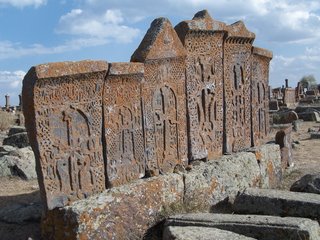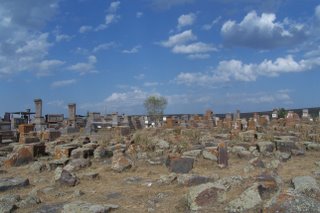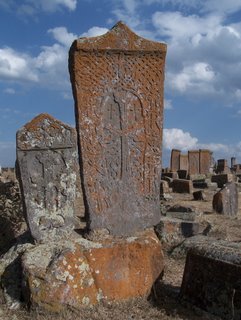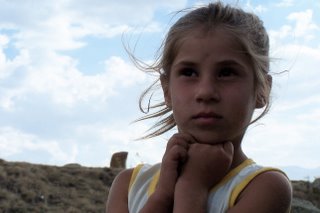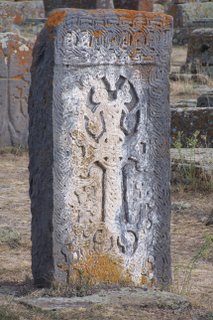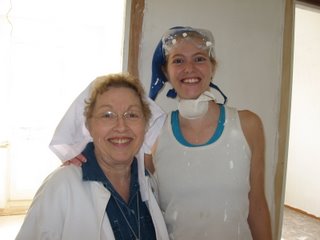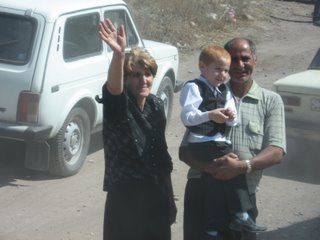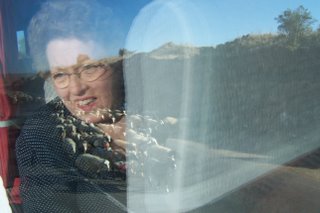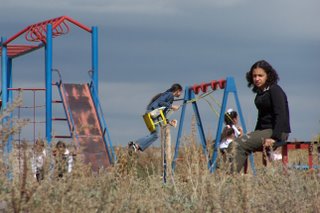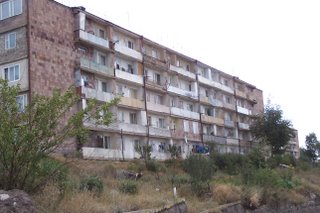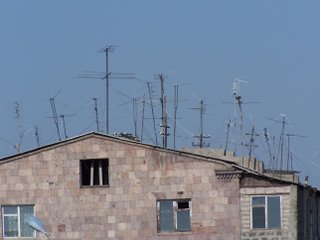 Californian couple, each aged 78, ties the knot amid combating poverty housing
Californian couple, each aged 78, ties the knot amid combating poverty housing
GAVAR, Armenia (Sept. 8)(Text from a Habitat for Humanity press release) The happy couple
The happy coupleRena and Jim never thought it would happen.
The 78-year-olds got hitched. On a construction site. In Armenia.
Habitat for Humanity volunteers Rena Davis and James Cradler, both widowed, have been courting for six months. Both lost their spouses in 2000, and both never imagined they’d get back into the marriage game. But the two met via a matchmaker: Jim’s daughter, Karen.
“That was a fateful Sunday,” Jim remembers with a twinkle in his eye. “We’d both had successful marriages, and we’d both adjusted to the lousy ‘single thing’. So when I saw that girl, that white hair, and that smile, I thought: ‘This could be interesting.’”
The Crescent City, California couple joined a Habitat for Humanity Global Village team to Armenia Sept. 5-9, for the “Catholicos Karekin II Work Project”, a blitz build of homes for 24 families in need. The project is part of a new partnership between the Armenian Apostolic Church and Habitat for Humanity aimed to combat poverty housing, signed earlier this year. Armenia, a country of 3 million nestled in the southern Caucasus, suffers a dire poverty housing problem: 45% of the country lives in poverty.
The Armenian adventure struck the couple’s fancy upon seeing an announcement on the “Faithful America” website. The founder of that site, Bob Edgar, General Secretary of the U.S. Council of Churches, a minister, and former U.S. congressman, happens to be a high-profile member of their volunteer construction team in Armenia. The reverend presided over their wedding ceremony, which was witnessed by more than 200 Habitat volunteers, families and supporters over the lunch break on the last construction day of the building week, among tears, cheers, singing monks, and traditional Armenian wedding dances. The bride was dressed in a Habitat for Humanity T-shirt, with an Armenian wedding garland of flowers in her hair. In another traditional Armenian gesture, the bride and groom tasted a spoonful of honey, to symbolize the sweetness of their union.
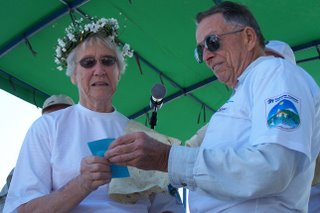 The couple shares their vows
The couple shares their vows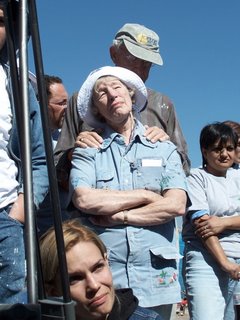 Bishop Clymer and wife Virginia watch the ceremony
Bishop Clymer and wife Virginia watch the ceremonyEdgar, who won the award, by a large margin, for ‘corniest jokes on a Habitat build’ cracked his team up – and elicited moans from others – with one-liners including “we are weapons of mass construction!” But Edgar offered to curb the corniness to preside over the wedding ceremony. Habitat staffers scrambled to contact a Methodist minister in the U.S. to fax over a copy of a wedding service. The symbolic marriage certificate, which read “Certificate of Spiritual Union”, Edgar says, is “totally illegal in the eyes of both the U.S., and Armenian governments, but blessed in the eyes of God!”
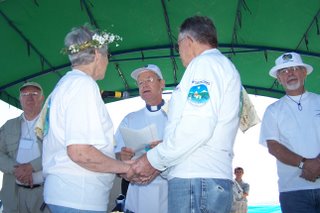 Dr. Edgar performs the ceremony
Dr. Edgar performs the ceremonyWhile the couple had been talking about marriage for some time, they’d never planned on tying the knot in Armenia. “Earlier this year we traveled to Reno to visit Jim’s brother, and everyone was afraid we’d go and get married there,” Rena says. “We promised we wouldn’t!
“But we never made any promises about Armenia!”
But on the building site, a cupid appeared, and acted as catalyst to speed the process up: Ken Bensen, Habitat for Humanity International Church Coordinator, a minister himself, and a main instigator of the Habitat partnership with the Armenian Apostolic Church. “I said to them: ‘I think you two ought to get married. Right here, on this building site!”
Rings, a cake, and an Armenian flower arrangement for the bride’s hair were quickly arranged by an enthusiastic group of Habitat volunteers, homeowners, priests, and a bishop. A local artist sketched an Armenian design on the wedding certificate.
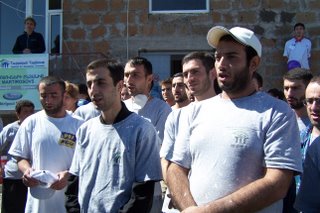 The monks sing during the ceremony
The monks sing during the ceremony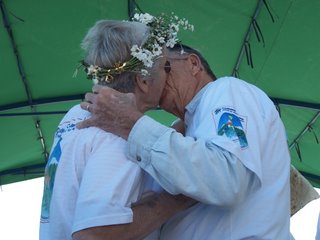 The kiss!
The kiss!“I think you’re having more fun than we are!” Rena told a group of paintbrush-wielding wedding planners.
As single Habitat volunteers on a building trip traditionally share hotel rooms to save money – men and women separated – the courting couple had been lodging with other volunteers. But upon the news, Habitat quickly arranged an ad-hoc bridal suite replete with candles and flowers for the couple’s wedding night.
“Some people will do anything to get their own room,” says a dry-humored Jim.
A Habitat staffer measured their ring sizes by tracing on paper the wedding bands they currently wear. “We wear our old wedding rings on purpose, so people know we’re taken. That way, we don’t have to beat them off with a stick,” Jim says.
Rena says she shared 52 wonderful years with her husband, who suffered from Parkinson’s disease. She never considered marrying again – until meeting Jim’s persistent daughter, Karen, at the pool where both swim regularly. Recalls Rena: “Karen suggested, ‘wouldn’t you like to meet my father? The two of you have so much in common.’ ”
Rena knew it was to be a “set up”. “I wasn’t interested,” Rena says. “But she is such a wonderful person, I figured she must have had some kind of good parental guidance.”
So she agreed. Karen invited Rena to coffee with her father on a Sunday morning. They all attended church service afterwards. “That was a fateful Sunday, March 19,” Jim remembers with a twinkle in his eye. “I invited her on a first date. What did I have to lose?”
“He phoned me,” Rena remembers, “and said ‘I’m a little out of practice, but would you like to go see the play ‘Fiddler on the Roof’ with me?”
They loved the Friday night play, went out for coffee afterwards, and talked until midnight. Saturday morning, Jim called again, for a breakfast date. He asked for a Sunday morning date, this time, to church. The repertoire theater performed ‘Fiddler’ for several weeks. The new lovebirds also went to the play’s closing performance.
“I chased her – but she didn’t run very fast!” Jim teases. “Ah-ha, but I can out-swim you any day!” Rena retorts.
“We’re having fun, at this time in our lives,” Rena said. “Isn’t that the best way?”
Contact:
Haykuhi Khachatryan: +374-10-55-61-14; haykuhi@hfharmenia.org
Tricia Deering: +3630-411-7056; tdeering@habitat.org Sharing the wedding cake
Sharing the wedding cake
